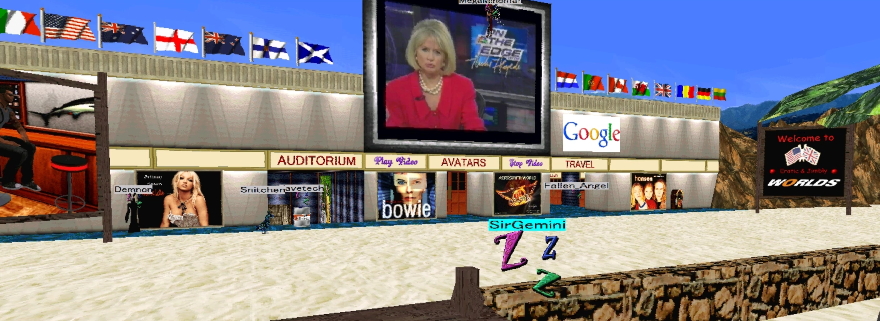
With the increased speeds of modems and the move into 3-D space in the 1990s, some game designers thought it was a logical conclusion to want to merge the two factors together to form immersive, 3-D virtual worlds that would host multiple users. A true cyberspace, in other words, that would grab the imaginations of the visually oriented public.
Before Second Life, Roblox, and other spiritual successors hit the scene, there was an interesting spat of titles in the mid-1990s that attempted to shape and formulate how a virtual world would look and function. Let’s take a look at these related projects today and see what came of them.
WorldsChat
Initially developed in 1994 by KnowledgeAdventure (which would be spun off into Worlds Inc.), WorldsChat took what the studio knew about creating virtual meeting spaces for companies and expanded it substantially. The small development team had to pioneer several techniques to make this kind of software work on a larger scale.
The idea behind WorldsChat wasn’t to make a game with levels and objectives, but rather a shared space station-themed virtual space that was designed for social interaction and personal creativity. LucasArts had already experimented with a graphical virtual world with its late-1980s Habitat, but Worlds Inc. wanted to go even further with the concept of empowering guests to interact with the world for their own delight.
WorldsChat allowed users to fly and teleport through its many settings while (as the name implies) talking with everyone they met. This early virtual world allowed players to customize their own avatars and zip around like in Doom to see what others “looked” like.
“WorldsChat rapidly attracted a set of regular inhabitants and sightseers who developed a culture to suit the environment,” wrote Bruce Damer in 1996. “At any time of the day or night, avatars could be seen engaged in intense chat or careening around the station discovering its passageways, rooms, and secret tricks. For the first time, there was ‘space’ in cyberspace and ‘visiting a place on the internet’ began to have real meaning.”
A virtual chat room? Sure, but the effort that went into constructing a world to explore and manipulate made it much more than just a chat window. Astoundingly, WorldsChat didn’t charge users to download or access the product, which diverged greatly from the hourly fees that MMORPGs charged.
“Worlds also made several abortive attempts to build MOORPGs based on the WorldsChat engine; none ever saw the light of day,” Jeremy Leader noted.
In an interesting side note, Worlds Inc ended up impressing filmmaker Steven Spielberg so much that he commissioned the studio to work with his Starbright Foundation to create “a 3-D virtual world in which seriously ill children in hospitals all over the United States could meet via a network to play.” This product, Starbright World, ran from 1995 to 1997.
Believe it or not, WorldsChat is around today. It went down in 1997 and was releaunched in 2000. Since then, it’s continued to operate and has received some attention due to YouTubers documenting their visits to thise mostly deserted virtual world.
AlphaWorld (Active Worlds)
A year later, Worlds Inc. took what they learned about building WorldsChat and created a new and improved virtual universe that it called AlphaWorld. Running from an internet browser, AlphaWorld was the first of what 700 themed realms that would be collectively known as Active Worlds.
Jeremy Leader clarified the relationship between these virtual world projects: “They say AlphaWorld was a successor product to WorldsChat, which isn’t quite correct; the two were developed in parallel with very different design goals (though they both used the same underlying 3-D renderer).”
AlphaWorld was vastly larger than its predecessor and offered players 12 avatar appearances. It also offered greater interaction with the world, letting players move around pre-made objects and start to shape the world. One such player project was a Sherwood Forest area with an old English feel and roleplayers taking on certain Robin Hood characters. The focus on building went a long way to setting AlphaWorld apart from the numerous other virtual world projects that began to pop up around this time.
Unfortunately, the tech wasn’t always able to handle all of the player activity and construction. Slower computers and connections suffered significantly and entered “slide show” territory.
One fun first happened on May 8th, 1996, when an AlphaWorld couple was married for the first time in a 3-D online virtual world. Friends created a wedding pavilion and coordinated their efforts in this player event. Mawwaiage! It’s what bwings us together today!
Another user, Topher McCulloch, recalled his interactions with AlphaWorld as a kid: “My early days were organized entirely around Star Wars. Cities were built in AlphaWorld with names like New Jedi and New Mos Espa. I re-created the entire Boonta Eve podracing course based on memory and screenshots of the Star Wars Episode I: Racer PC Game, which I didn’t even own.”
If you’re curious what users were able to do with these primitive tools, you might be astounded to gaze over this list of impressive constructions.
Active Worlds exploded in population and popularity from 1995 through 2001, giving countless players a chance to claim and own a small slice of a graphical world. Happily, Active Worlds is still alive and kicking, having celebrated its 25th anniversary. But if you visit, well, you might see a product of an early era that hasn’t aged that well.
“Virtual picture frames that pointed to images hosted on external sites are now ghostly embodiments of dead links — static-filled picture frames that leave physical scars on the virtual environment,” McCulloch wrote in 2015. “With error messages turned on, the chat window fills with broken links to sounds and pictures that read like a who’s who of deceased free hosting services.”
There were, of course, numerous other virtual world projects that emerged in the mid-1990s, including Worlds Away, Virtual Places, Comic Chat, and The Palace. But the technology wasn’t quite there yet, and so it took a few more years until Second Life and the next generation of visual virtual worlds emerged to take advantage of faster computers and connections.
 Believe it or not, MMOs did exist prior to World of Warcraft! Every two weeks, The Game Archaeologist looks back at classic online games and their history to learn a thing or two about where the industry came from… and where it might be heading.
Believe it or not, MMOs did exist prior to World of Warcraft! Every two weeks, The Game Archaeologist looks back at classic online games and their history to learn a thing or two about where the industry came from… and where it might be heading.















